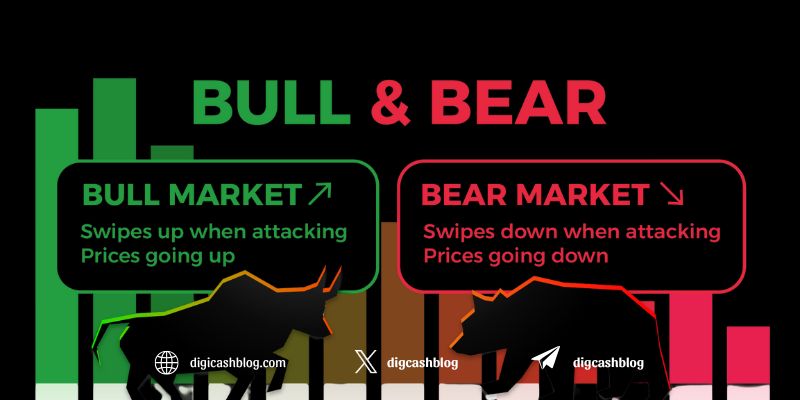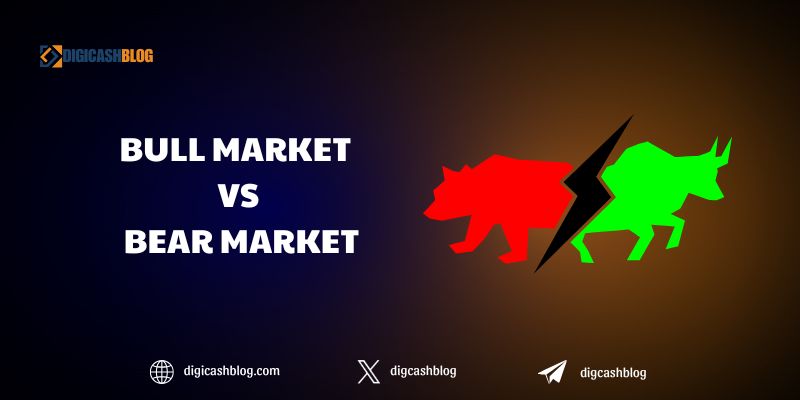Understanding the crypto bull market vs bear market in 2025 is critical for traders and investors aiming to navigate this volatile ecosystem. A bull market is defined by rising prices and optimism, while a bear market features falling prices and pessimism. This article compares these market phases, their drivers, and how technical and on-chain analysis can help market participants capitalize on opportunities or mitigate risks in 2025.
What is a Crypto Bull Market?
A bull market in crypto is a period of sustained price increases, driven by strong demand, positive sentiment, and growing adoption. In 2025, bull markets are fueled by several key factors:
-
Institutional Adoption: The influx of institutional capital through Bitcoin ETFs (e.g., BlackRock’s $15 billion in assets) and corporate treasury allocations (e.g., MicroStrategy) drives demand for Bitcoin and Ethereum, pushing prices higher.
-
Regulatory Clarity: Pro-crypto policies, such as the U.S. repeal of the IRS’s DeFi broker rule and the EU’s MiCA framework, boost investor confidence, as highlighted in X posts.
-
Technological Advancements: Scalability improvements via Layer 2 solutions (e.g., Arbitrum, Optimism) and DeFi’s $200 billion TVL in 2025 support bullish trends for altcoins like Solana and Cardano.
-
Market Sentiment: Optimistic posts on X, often amplifying memecoin rallies (e.g., Dogecoin), contribute to short-term price surges within broader bull cycles.
-
On-Chain Metrics: On-chain analysis shows increased active addresses (e.g., Ethereum’s 1.2 million daily) and exchange outflows (e.g., $1 billion Bitcoin outflows in Q1 2025), signaling accumulation and bullish momentum.

What is a Crypto Bear Market?
A bear market is marked by prolonged price declines, typically exceeding 20%, accompanied by fear and reduced market activity. In 2025, bear markets are influenced by:
-
Macroeconomic Shocks: Events like U.S. trade tariffs in Q1 2025, which caused a Bitcoin price dip from $108,786, trigger short-term bearish phases, as noted in X discussions.
-
Regulatory Uncertainty: Despite progress, fragmented global regulations can spark sell-offs, particularly for altcoins in restrictive jurisdictions.
-
Whale Selling: Large-scale liquidations by whales, tracked via on-chain analysis, can exacerbate price drops. For instance, significant inflows to exchanges often precede bearish movements.
-
Market Overheating: Speculative bubbles in memecoins or overvalued altcoins can lead to sharp corrections, as seen in past Dogecoin dumps.
-
Reduced Network Activity: Declining on-chain metrics, such as lower transaction volumes or active addresses, signal waning interest, reinforcing bearish sentiment.
Technical Analysis in Bull and Bear Markets
Technical indicators help traders navigate both market phases:
-
Moving Averages (MA): In a bull market, prices above the 200-day Simple Moving Average (SMA) or a Golden Cross (50-day SMA crossing above 200-day SMA) confirm upward trends, as seen in Bitcoin’s 2024 rally. In a bear market, a Death Cross (50-day SMA crossing below 200-day SMA) or prices below the 200-day SMA signal continued declines.
-
Volume Analysis: High trading volume validates bull market breakouts, while low volume in bear markets indicates weak buying interest. For example, a Solana breakout with spiking volume confirms bullish momentum, while declining volume during a price drop suggests capitulation.
-
RSI and Bollinger Bands: In bull markets, RSI above 70 with prices near the upper Bollinger Band may indicate overbought conditions, signaling caution. In bear markets, RSI below 30 near the lower Bollinger Band suggests oversold conditions, as seen in Ethereum pullbacks in Q1 2025.
-
Fibonacci Retracement: In bull markets, Fibonacci levels (e.g., 38.2%, 61.8%) identify support during pullbacks, while in bear markets, they highlight resistance during recoveries.
On-Chain Analysis for Market Insights
On-chain analysis provides deeper context for bull and bear markets:
-
Bull Market Signals: Rising active addresses, exchange outflows, and HODL Waves (indicating long-term holding) support bullish trends. For instance, Bitcoin’s $1 billion exchange outflows in Q1 2025 signaled a bull market continuation.
-
Bear Market Signals: Exchange inflows, declining transaction volumes, and reduced network activity indicate bearish pressure. A drop in Ethereum’s active addresses during a price decline confirms weakening demand.
-
Application: Tools like Glassnode or CryptoQuant help traders monitor these metrics to anticipate market shifts.
Comparing Bull and Bear Markets in 2025
-
Price Behavior: Bull markets feature sustained uptrends with higher highs and lows, while bear markets show lower lows and highs, often triggered by external shocks.
-
Sentiment: Bull markets are driven by optimism and FOMO (fear of missing out), amplified on X, while bear markets are marked by fear and panic selling.
-
Investment Strategy: Bull markets favor buy-and-hold or trend-following strategies, using EMA crossovers for entries. Bear markets suit short-selling or hedging with stablecoins, leveraging RSI for oversold opportunities.
-
Risk Levels: Bull markets offer high returns but risk corrections, while bear markets require strict risk management to avoid losses.

Challenges in Navigating Market Cycles
-
Volatility: Sudden price swings, like those caused by 2025 tariffs, challenge both bull and bear market strategies.
-
Speculative Noise: Memecoin pumps in bull markets or panic selling in bear markets, often amplified on X, can mislead traders.
-
Data Manipulation: Wash trading on exchanges distorts volume analysis, necessitating on-chain analysis for accuracy.
-
Regulatory Shifts: While long-term clarity supports bull markets, short-term regulatory news can trigger bearish corrections.
The crypto bull market vs bear market in 2025 highlights the cyclical nature of the $2.66 trillion cryptocurrency ecosystem. Bull markets, driven by institutional adoption, regulatory clarity, and technological advancements, offer opportunities for long-term growth, while bear markets, triggered by macroeconomic shocks or whale selling, demand caution. By leveraging on-chain analysis, volume analysis, and technical tools like Moving Averages and RSI, traders can navigate both phases effectively. Staying informed through platforms like X and maintaining robust risk management will enable market participants to capitalize on opportunities and mitigate risks in the dynamic crypto market of 2025.
